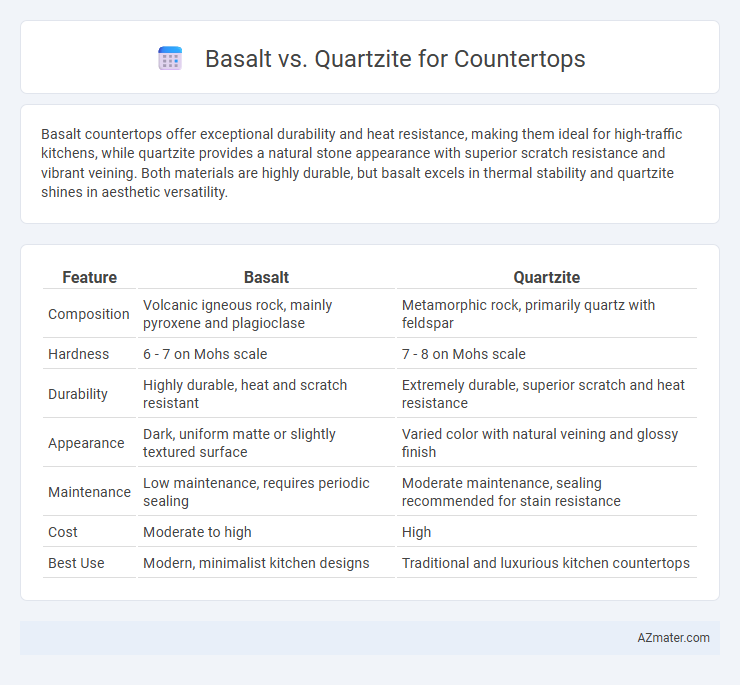Basalt countertops offer exceptional durability and heat resistance, making them ideal for high-traffic kitchens, while quartzite provides a natural stone appearance with superior scratch resistance and vibrant veining. Both materials are highly durable, but basalt excels in thermal stability and quartzite shines in aesthetic versatility.
Table of Comparison
| Feature | Basalt | Quartzite |
|---|---|---|
| Composition | Volcanic igneous rock, mainly pyroxene and plagioclase | Metamorphic rock, primarily quartz with feldspar |
| Hardness | 6 - 7 on Mohs scale | 7 - 8 on Mohs scale |
| Durability | Highly durable, heat and scratch resistant | Extremely durable, superior scratch and heat resistance |
| Appearance | Dark, uniform matte or slightly textured surface | Varied color with natural veining and glossy finish |
| Maintenance | Low maintenance, requires periodic sealing | Moderate maintenance, sealing recommended for stain resistance |
| Cost | Moderate to high | High |
| Best Use | Modern, minimalist kitchen designs | Traditional and luxurious kitchen countertops |
Introduction to Basalt and Quartzite Countertops
Basalt countertops are made from volcanic rock characterized by their durability, heat resistance, and unique dark tones with subtle texture variations. Quartzite countertops originate from natural sandstone, offering exceptional hardness and a marble-like appearance with a wide range of colors and veining patterns. Both materials provide excellent scratch and heat resistance, making them popular choices for kitchen and bathroom surfaces.
Composition and Formation of Basalt and Quartzite
Basalt is an igneous rock primarily composed of plagioclase and pyroxene minerals, formed from the rapid cooling of basaltic lava at the Earth's surface, resulting in a dense, fine-grained texture. Quartzite is a metamorphic rock derived from sandstone, rich in quartz minerals that recrystallize under intense heat and pressure, creating a hard, non-porous surface ideal for countertops. The fundamental difference in their formation processes--igneous cooling for basalt and metamorphic recrystallization for quartzite--affects their durability, appearance, and suitability in countertop applications.
Appearance and Color Variations
Basalt countertops exhibit a deep, uniform black or dark gray color with a matte or honed finish, offering a sleek and modern appearance that emphasizes minimalism. Quartzite countertops provide a more varied palette, ranging from white and gray to green, pink, and even blue, often featuring natural veining patterns that add dynamic visual interest. The subtle, consistent coloration of basalt contrasts with quartzite's diverse hues and intricate textures, making each material distinct in creating either a monochromatic or richly patterned countertop surface.
Durability and Hardness Comparison
Basalt and quartzite countertops both offer exceptional durability, with quartzite typically ranking higher on the Mohs hardness scale at around 7 compared to basalt's average of 6, making quartzite more resistant to scratches and etching. Both materials are highly dense and resistant to heat, but quartzite's crystalline structure provides superior toughness, reducing the likelihood of chipping or cracking under heavy use. Basalt's fine-grained composition offers moderate hardness and durability, suitable for everyday kitchen activities, while quartzite's hardness and resistance make it ideal for high-traffic areas demanding long-lasting surfaces.
Resistance to Heat and Scratches
Basalt countertops offer superior resistance to heat due to their volcanic origin, making them highly durable for high-temperature applications in kitchens. Quartzite, while also heat resistant, can be more susceptible to etching and minor scratches compared to basalt's dense, fine-grained structure. Both materials provide strong scratch resistance, but basalt's hardness and compactness often give it a slight edge in maintaining surface integrity over time.
Maintenance and Cleaning Requirements
Basalt countertops require minimal maintenance due to their dense, non-porous surface, making them highly resistant to staining and moisture absorption, thus requiring only regular wiping with mild soap and water for cleaning. Quartzite, while also durable and resistant to heat, is more porous than basalt and benefits from periodic sealing to prevent staining and maintain its polished appearance; cleaning involves gentle, non-abrasive cleaners to avoid damaging its natural sheen. Both materials offer long-lasting beauty, but basalt's lower porosity makes it easier to maintain in high-traffic kitchen environments.
Installation Complexity and Cost
Basalt countertops often present higher installation complexity due to their extreme hardness and density, requiring specialized tools and skilled labor, which directly increases labor costs. Quartzite, while also very durable, is slightly less challenging to install, resulting in lower overall installation expenses compared to basalt. Material costs for basalt are generally higher because of limited availability and extraction difficulty, whereas quartzite offers a more cost-effective balance between durability and installation feasibility.
Environmental Impact and Sustainability
Basalt and quartzite countertops differ in environmental impact, with basalt being a volcanic rock that requires minimal processing, resulting in lower carbon emissions and reduced energy consumption. Quartzite, a metamorphic rock, often involves more intensive quarrying and refining methods, increasing its ecological footprint. Both materials are durable and long-lasting, reducing the need for frequent replacement, but basalt's natural abundance and low processing requirements make it a more sustainable option for eco-conscious homeowners.
Pros and Cons of Basalt Countertops
Basalt countertops offer exceptional durability and heat resistance, making them ideal for high-traffic kitchen areas, but they can be more prone to chipping compared to quartzite. Their natural dark hues provide a sleek, modern aesthetic, yet basalt's limited color variety might not suit all design preferences. Maintenance of basalt is relatively low, requiring periodic sealing to prevent staining and preserve its polished surface.
Pros and Cons of Quartzite Countertops
Quartzite countertops offer exceptional hardness and durability, resisting scratches and heat better than many natural stones, making them ideal for busy kitchens. However, quartzite is more porous than granite or quartz, requiring regular sealing to prevent staining and maintain its appearance. Despite its high maintenance, quartzite provides a unique, elegant aesthetic with natural veining and a wide range of colors that enhance countertop design.

Infographic: Basalt vs Quartzite for Countertop
 azmater.com
azmater.com